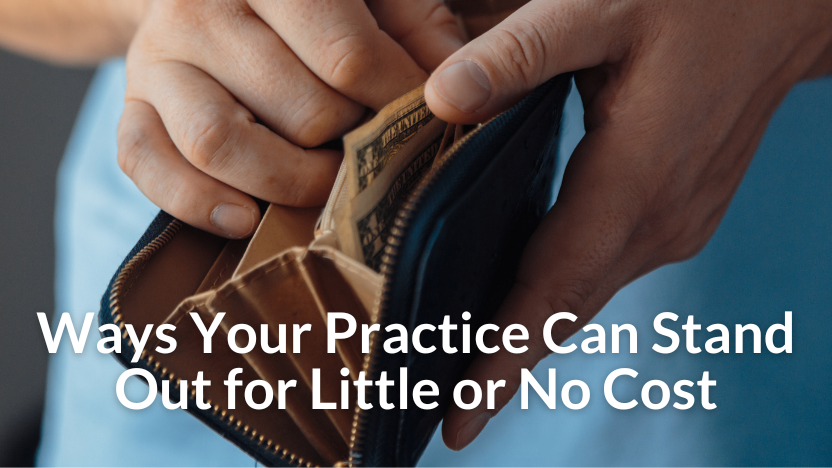How to Stand Out and Spend Less (and How EyePromise® Can Help)
Posted by EyePromise on Feb 1st 2024
When running an optometry practice, it’s imperative to differentiate yourself from other practices. Some do this by creating an unmatched ambiance, while others choose to specialize in an area of eye care. However, many of the options that help practitioners stand out can cost a pretty penny. Alan P. Levitt, OD, has found several ways to help your eye care practice differentiate itself without breaking the bank.
Designate a Staff Member to Help Manage Your Programs Internally.
Think social media, a new testing protocol, nutritional care, etc. These programs can take time to become part of your routine. Nominating a staff member can help engrain the new program into daily practice while bolstering that team member’s connection to the practice. At EyePromise, we call this person the Program Champion.
Make Punctuality an Intentional Goal.
When it comes to timeliness in healthcare, many patients are unimpressed. It’s not uncommon for appointments to run behind and for patients to be stuck in waiting rooms for some time. That’s why running a tight ship and keeping a close eye on the schedule can help you stand out from other practices. Not only does it help your office run smoother, so your staff is less stressed. It also shows that you respect and value patients’ time as much as your own.
Offer Same-Day Visits for Medical Eye Emergencies.
This should not be a surprise. Of course, if you offer same-day services, you’ll stand out amongst many other offices. However, choosing which services you see with same-day appointments is crucial to success. Dr. Levitt recommends offering emergency services on the same day, but other services require appointments made ahead of time.
If you’re worried about time management because punctuality is an intentional goal, try building in “admin time” to your daily schedule. This allows you and your staff to catch up on any kind of administrative tasks while building in an appointment slot for a same-day emergency visit.
Focus On Patient Education.
There were a few different specific items that Dr. Levitt called out in his article with Review of Optometric Business that fall under this category. The foundational point is that educated patients can make informed decisions, creating a better dynamic between practitioner and patient as well as increasing the chances of that patient adhering to your prescribed care protocol.

Inform While You Perform.
While efficiency is important to keeping a schedule, you should take the time to explain the exam, measure, test, etc. that you’re administering. Tell patients what it is, what it will do, what it measures, and why you want to measure it. You don’t necessarily need to stop what you’re doing, but informing while you’re performing the exam can help ease anxiety and create an educated patient who feels in control of their eye health.
Utilize Patient Education Tools on the Specific Issue or Product.
There are few things worse for a patient than receiving notice of an eye health issue or being prescribed a product and not having any clue what it is. As mentioned, educated patients feel in control of their eye health and, therefore, are more likely to adhere to your recommendations. You should be providing your patients with educational tools, whether they’re physical like patient brochures or digital like videos, so patients can take the time to fully understand what you’re telling them.
As your practice partner, EyePromise offers many patient education tools for you to utilize within your practice. From eye health issue-focused material to product-specific, we have both digital and physical pieces that you can use with your patients. Oh, and did we mention they are completely free for our partners?
Review All Results With Patients and Compare to Baseline If Applicable.
Once again, a well-informed patient feels more empowered to take control of their eye health. That’s why Dr. Levitt recommends reviewing all exams and test results with patients, even if there’s nothing to report. Showing patients their exams help make the results more real, and if there’s “nothing” to report, then you can use this opportunity to encourage the patient to keep doing what they’re doing.
Provide Written Instructions of All Prescribed Care Protocols.
It can be overwhelming for patients to be identified with an eye health issue or receive a new prescription. While they may say that they fully understand your recommendation in the exam room, odds are that they’ll forget at least a few of the details. Levitt stresses that written instructions help ensure that your care protocols are followed to the letter.
EyePromise provides our partners with product-specific prescription pads that include dosage instructions, so your patients know exactly what to do when they leave your practice. Along with your recommendations, you should discuss the common side effects of any of the products prescribed and what to do should your patient experience any of them.
Build Doctor-to-Doctor Communication Into Your Protocol.

The optometry industry is no stranger to referrals. Whether it’s to a retinal specialist or an endocrinologist, eye care practitioners often refer patients to other specialists due to findings in their eye exam. While this is absolutely an important role optometrists play, Dr. Levitt believes in providing a more robust report to these referred practitioners. His recommendation: share a written summary of findings, results, and concerns that includes your presumed identification of the issues and any specific testing you want to see.
Along with your findings and recommended exams, you should also inform the referred practitioner about what you plan to do in terms of care protocol with the patient. Did you recommend a nutraceutical? Specialized contact lenses? A warm compress and lid cleaner? The more information they have, the better they can help your patient. Levitt also recommends requesting a written report from the referred practitioner and following up with the patient once the visit is complete.
Finally, make sure you include the primary care physician in this communication plan. Most patients have and see a primary care physician regularly, and they can often take away and add protocols for patients that can interfere with your care plan. By communicating with them what you’ve recommended to your patient and why, they can take this into consideration when making another prescription. EyePromise has doctor-to-doctor letters already crafted for our partners to utilize as they see fit. Again, completely free.
Return All Calls.
Set a policy within your practice to return all calls within a certain timeframe, but make sure it’s realistic for your office. While Dr. Levitt tries to return all calls in the same day and simply doesn’t leave until he does so, you can choose to return calls within 24-48 hours. Whatever you choose, make sure it’s clear to your team, both associate doctors and staff, that this policy needs to be followed.
Establish Strict and Routine Cleaning Protocols.
From instruments to restrooms, patients want to feel like your practice is clean. Dr. Levitt instituted a cleaning policy that had staff members cleaning the exam room and tools in front of the next patient. While this slows patient flow, his patients were confident that his practice was clean, even during the COVID-19 pandemic. This kind of cleaning policy may not work for your practice, but if you don’t already have one established, you should, as it could be the difference between standing out and being brushed over.
Ensure There’s Always a “Friendly Face.”

Optometry, like other aspects of healthcare, is a person-focused industry. Dr. Levitt ensures that his patients always have a “friendly face” to speak to. Whether it’s on the phone or in person, Levitt has his team stagger their lunch breaks to make sure the front desk and phones are always covered.
Make Sure Samples and Trials Are Always Stocked.
Finally, Dr. Levitt says to always be sure your sample and trial products are fully stocked for the days ahead. You shouldn’t have to tell patients to schedule another time to come back for a sample. It’s not respectful to their time (or yours). If you see you’re running low, contact the company rep and see about getting more before you may need it to help create a better patient experience and increase the chances of purchase.
When it comes down to it, simply paying closer attention to the experience a patient has in your practice can be the difference between a loyal customer and a detractor. EyePromise can help you build a nutritional center of excellence while providing essential tools geared toward practice and patient success. Learn more about becoming an EyePromise partner.

